Physical Sciences P1 Grade 12 Memorandum - NSC Exams Past Papers and Memos September 2019 Preparatory Examinations
Share via Whatsapp Join our WhatsApp Group Join our Telegram Group
MEMORANDUM
QUESTION 1:
MULTIPLE-CHOICE QUESTIONS
1.1 C ?? (2)
1.2 A ?? (2)
1.3 B ?? (2)
1.4 C ?? (2)
1.5 D ?? (2)
1.6 A ?? (2)
1.7 D ?? (2)
1.8 B ?? (2)
1.9 A ?? (2)
1.10 D ?? (2) [20]
QUESTION 2
2.1 A body will remain at rest or motion with constant velocity unless a non-zero resultant/net force acts on it. ??
OR
An object will continue in a state of rest or uniform velocity, unless it is acted upon by an unbalanced force. ??(2)
NOTE:
- If any of the underlined key words in the correct context is omitted deduct 1 mark.
2.2 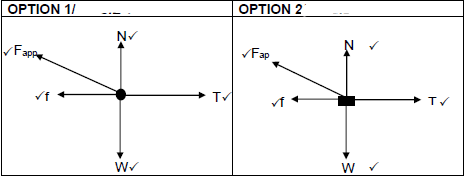
(5)
- Accept if learners draw the components of the applied force.
- Mark awarded for arrow and label.
- Do not penalise for length of arrows since drawing is not drawn to scale.
- Any other additional force(s) 4/5
- If force(s) do not make contact with body. Max. 4/5
2.3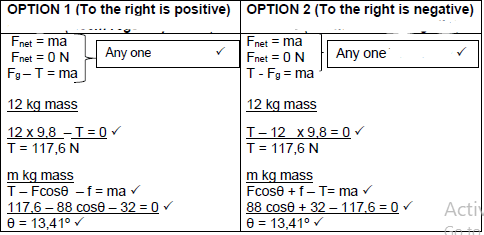
(5)
2.4 Positive marking from 2.3
fk =μkN
32 = (0,12) N? Any one ?
N = 266,67 N
OR
N = mg – Fsinθ
266,67 = m x 9,8 – 88 sin13,41º ?
m = 29,29 kg? (4)
2.5 Remains the same ? (1) [17]
QUESTION 3
3.1
3.1.1
| OPTION 1 UPWARD POSITIVE | OPTION 2 UPWARD NEGATIVE |
 |  |
(4)
3.1.2
| OPTION 1 UPWARD POSITIVE | OPTION 2 UPWARD NEGATIVE |
 |  |
| OPTION 3 UPWARD POSITIVE | OPTION 4 UPWARD NEGATIVE |
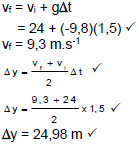 | 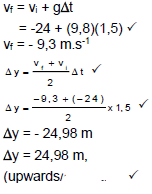 |
(4)
3.2 Positive marking from 3.1.1
| OPTION 1 UPWARD POSITIVE | OPTION 2 UPWARD NEGATIVE |
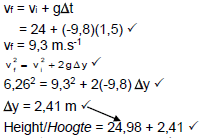 | 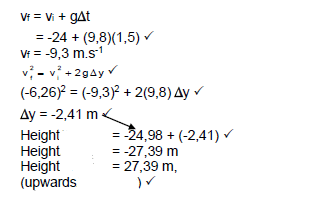 |
(6) [14]
QUESTION 4
4.1 In an isolated system total linear momentum is conserved. ?? (2)
NOTE:
- If any of the underlined key words in the correct context is omitted deduct 1 mark.
4.2 EAST IS POSITIVE
- ∑pi = ∑pf
mAviA + mBviB = mAvfA + mBvfB
mAviA + mBviB = (mA + mB)vf
52,5 x viA + 42 x -4 ? = 0 ?
viA = 3,2 m.s-1, right/regs ? (4)
4.3 670 N west/wes ? (No mark if only magnitude is given) (1)
4.4
- Fnet ∆t = ∆p
Fnet ∆t = mvf - mvi
670 x 0,5 ? = 42 (vf – 0) ?
vf = 7,98 m.s-1 ? (4) [11]
QUESTION 5
5.1 In an isolated system the total mechanical energy remains constant. ?? (2)
NOTE:
- If any of the underlined key words in the correct context is omitted deduct 1 mark.
5.2
- WFg = - ΔEp
WFg = - mg (h2 – h1)
WFg = -1,5 x 9,8 (0 – 3) ?
WFg = 44,1 J ? (3)
5.3 A force is non-conservative if the work it does on an object which is moving between two points depends on the path taken. ?? (2)
NOTE:
- If any of the underlined key words in the correct context is omitted deduct 1 mark.
5.4 Positive marking from 5.2
| OPTION 1 | OPTION 2 |
 | 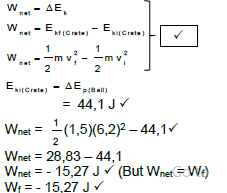 |
| OPTION 3 | |
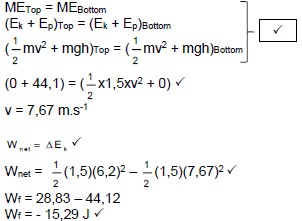 | |
(5) [12]
QUESTION 6
6.1 The change in frequency (or pitch), of the sound detected by a listener because the sound source and the listener have different velocities relative to the medium of sound propagation. ??
OR
An (apparent) change in observed/detected frequency (pitch), as a result of the relative motion between a source and an observer. ?? (2)
NOTE:
- If any of the underlined key words in the correct context is omitted deduct 1 mark.
6.2 871 Hz ? (1)
6.3 As the learner stands next to the sound source, the detector registers the frequency of the source because there is no relative motion. ? As the learner moves away from the source the waves become stretched out, ? the wavelength become longer and the frequency become lower. ? (3)
6.4
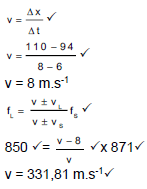 (7)
(7)
6.5
- Used to measure the direction and speed of blood flow in arteries and veins. ? ?
- Used to monitor the heartbeat of a newly formed foetus. ? (2) [15]
QUESTION 7
7.1 25º ? (1)
7.2 The magnitude of the electrostatic force exerted by one point charge (Q1) on another point charge (Q2) is directly proportional to the product of the (magnitudes) of the charges and inversely proportional to the square of the distance (r) between them. ?? (2)
NOTE:
- If any of the underlined key words in the correct context is omitted deduct 1 mark.
7.3
- T sin θ = FE
480 sin 25° = FE ?
FE = 202,8567656 N
FE = kQ1Q2?
r2
202,8567656 ?= 9 x 109 x Q2 ?
0 , 022
Q = 3,00 x 10-6 C ? (5)
7.4.1 Positive marking from 7.3.
| OPTION 1 | OPTION 2 |
 | 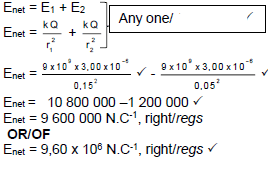 |
(5)
7.4.2 Positive marking from 7.3.
| OPTION 1 | OPTION 2 |
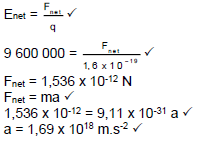 | 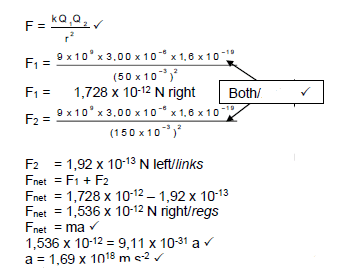 |
[18]
QUESTION 8
8.1
| OPTION 1 | OPTION 2 |
1 = 1 + 1 | RP = R1R2 R1 + R2 RP = 6 × 8 6 + 8 RP = 3,43 Ω ? |
(3)
8.2
8.2.1
- Cost= E(kWh) x price
6,75 = E(kWh) x 1,50 ?
E(kWh) = 4,5 kWh
P = W ?
Δ t
P = 4 , 5 ?
5 x 5
P = 0,18 kW
P = 180 W ? (4)
8.2.2 Positive marking from 8.2.1
P = VI ?
180 = (60)I ?
I = 3 A ? (3)
8.3
8.3.1 Positive marking from 8.1 and 8.2.2
R = V ?
I
1 = V ?
3
Vr = 3 V
Vp = 10,29 V
Emf = Vload + Vr
Emf = 60 + 10,29 + 3 ?
Emf= 73,29 V ? (5)
8.3.2 Positive marking from 8.1, 8.2.1 & 8.2.2
| OPTION 1 | OPTION 2 |
| |  |
| OPTION 3 | OPTION 4 |
 |  |
QUESTION 9
9.1 Mechanical ? to electrical ?
9.2 To reverse the direction of the current each half cycle. ?
OR
Allow for constant direction of rotation of the coil. ?
9.3
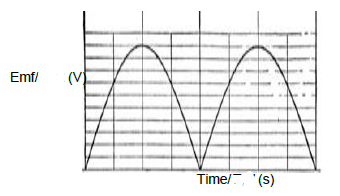
- D.C.graph
- Two peaks only (one cycle)
9.4
- Increase the strength of the magnetic field
- Increase the number of turns on the coil
- Rotate the coil faster
Any one ?
QUESTION 10
10.1 The DC potential difference/voltage that dissipate the same amount of energy as an AC source. ?? (2)
NOTE:
If any of the underlined key words in the correct context is omitted deduct 1 mark.
10.2
| OPTION 1 | OPTION 2 |
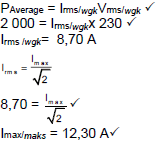 |  |
QUESTION 11
11.1 The minimum frequency required to emit electrons from a metal surface. ?? (2)
NOTE:
If any of the underlined key words in the correct context is omitted deduct 1 mark.
11.2
- Wo = hfo ?
Wo = (6,63 x 10-34)(1,50 x 1014) ?
Wo = 9,95 x 10-20 J ? (3)
11.3 Positive marking from 11.2
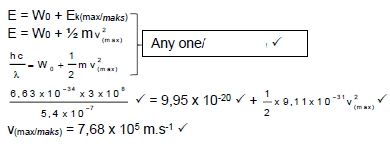
11.4
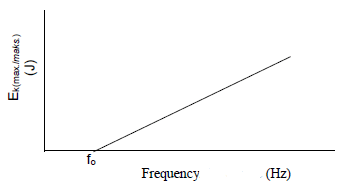
Correct shape | ? |
Both axes labeled | ? |
Threshold frequency, fo | ? |
TOTAL: 150